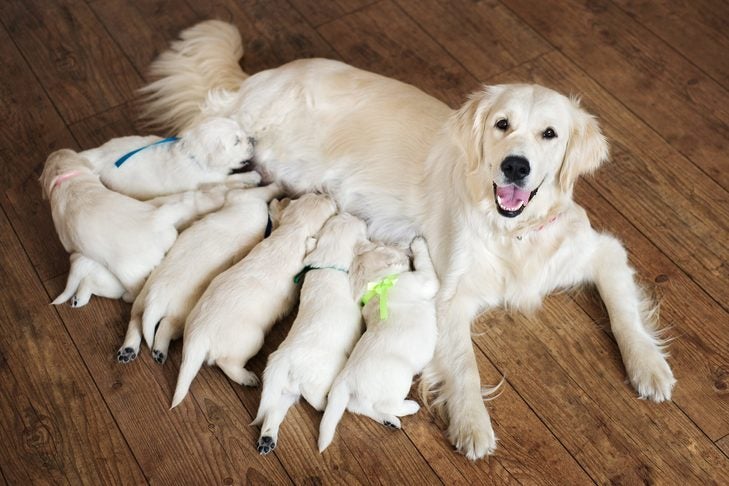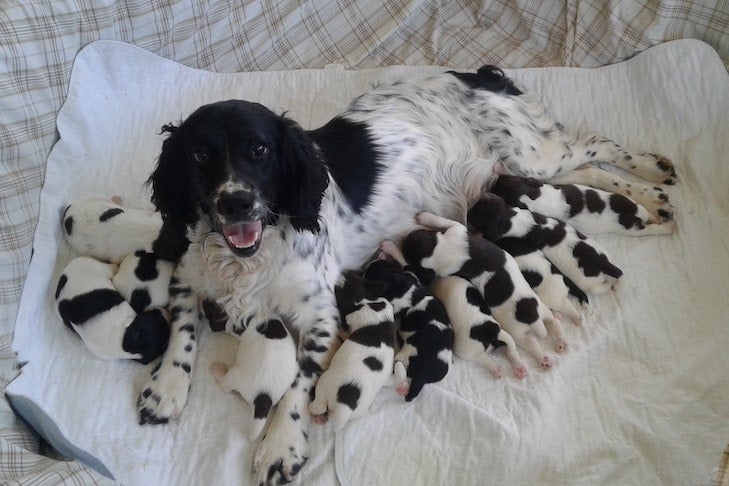
Breeding dogs and producing puppies is a rewarding experience. Every litter is unique in some ways, and it takes many years to gain the experience to recognize signs of potential problems and know what steps can be taken to intervene and potentially save the lives of puppies.
Breeders should be present when a dam delivers her puppies, especially if it is her first litter or if she is an older female. You may be able to take quick action, if needed, to help prevent the mortality of puppies. During whelping, one of the most common causes of puppy mortality is hypoxia, or a lack of oxygen. A green or greenish-black discharge from the dam indicates placental separation.
“If this discharge appears and not all the puppies are whelped, they may not be getting enough oxygen,” advises Fran Smith, DVM, Ph.D., DACT, a board-certified veterinary reproduction specialist.
Other signs of potential problems include strong persistent labor for 30 minutes without delivery of a puppy, weak or intermittent labor for six hours without delivery of a puppy, or three or more hours having had passed since the last puppy was born, with more puppies expected to be delivered.
“I recommend having a pregnancy radiograph taken during the last week of pregnancy so that the number of expected puppies is known,” says Dr. Smith.
Giving medications such as oxytocin or ergometrine to induce labor in females having weak contractions could contribute to hypoxia. According to Dr. Smith, you should consult your veterinarian before using these medications, as they facilitate premature placental separation and can be dangerous.
If neonates are small in size when they are born, you can help stimulate their respiration and keep them warm by rubbing their bodies and drying them. Newborn puppies with a low birth weight may have immature lungs, which could cause them to become hypothermic with a dangerously low body temperature.
“The neonatal period from birth to 3 days of age is a critical stage for puppies,” cautions Dr. Smith. “Intervention in the first 72 hours should be used judiciously. Experience can help tell you when to intervene. if you are unsure, you should talk to your veterinarian.”
The First 72 Hours
If you notice these signs in puppies during the first 72 hours after birth, you may need to consult your veterinarian. Intervention could save the life of a newborn puppy at risk.
- Poor nursing
- Separation by the bitch
- Lying on its side instead of chest
- Lying with its mouth open
- Little movement compared to the rest of the litter
- Restlessness and crying despite appearing to nurse
Whelping Tips for Breeders
- Be sure the whelping box has adequate heat around 85 degrees, as puppies are not able to make their own body heat until they are 2 ½ weeks old. The whelping area should be clean and quiet and provide a comfortable, stress-free environment.
- Plan to be present when a dam delivers her puppies, especially if it is her first litter or if she is an older female. You may be able to take quick action, if needed, to help prevent the mortality of puppies.
- If neonates are small in size when they are born, you can help stimulate their respiration and keep them warm by rubbing their bodies and drying them. Newborn puppies with a low birth weight may have immature lungs, which could cause them to become hypothermic with a dangerously low body temperature.
- Consult your veterinarian before giving medications such as oxytocin or ergonovine to increase uterine contractions. These medications can be dangerous as they facilitate premature placental separation, which can cause the potentially fatal condition of hypoxia or a lack of oxygen.

Caring for Newborn Puppies and Dams
Once puppies are whelped, it is important to monitor their weight at birth, after 12 hours, and after 24 hours to ensure they are growing. Most normal puppies nearly double their birth weight in the first week. In large litters, two or three of the smallest puppies may need assistance with suckling to help them on their way.
“Breeders should be attentive as to whether the puppies are nursing,” says Dr. Smith. “Puppies should gain 1 gram daily per expected adult body weight in pounds. for example, a Labrador Retriever puppy should gain at least 60 grams, or 2 ounces, daily. If puppies are not gaining at that rate, they should be supplemented with a formula that contains maltodextrin to promote weight gain.”
“A first-time dam may be overwhelmed, and you may need to lay her on her side and put the puppies on the nipples for a few days until she takes over. Some older dams develop large, fleshy nipples that can make it difficult for a small or weak puppy to grasp. You may need to help these puppies nurse until they are stronger.”
Breeders should introduce a dam to the whelping box at least five days before her delivery date to become comfortable and adjusted before the puppies are born. The whelping box should be one and a half to two times the length of the dam, so she can stretch out in full length with room to spare. The dam should be able to get away from her puppies into a separate area, without the puppies escaping. A railing or ledge — sometimes called a pigrail, bumper, or puppy rail — that is 3 to 4 inches from the floor around the periphery helps prevent the dam from crushing or suffocating a puppy caught between her body and the sides of the box. The whelping box should have a consistent temperature around 85 degrees, as puppies are not able to generate their own body heat until they are 2 ½ weeks of age.
“Excessively high temperatures and high humidity can cause respiratory difficulties and dehydration in puppies. Dams that are overly warm may spend less time with their puppies and produce less milk,” cautions Dr. Smith.
More Breeding Best Practices
A supplemental heat source may be needed for the first two weeks when puppies rely on the dam’s body heat and the warmth of littermates to maintain a normal body temperature. A heat source in the center of the whelping box encourages puppies to stay away from the edges where there is a greater risk for the dam to lie on them. Appropriate heat sources include heat lamps, electric or water-filled heating pads, and microwavable heating pads.
The best bedding materials for a whelping box are soft, warm, have good traction, and are easily cleaned and disinfected. They should be insect-free, moisture resistant, and not easily ingested by puppies. You should avoid hay, straw, shavings, or stiff particles that can cause eye and skin irritation. Materials such as rags, blankets, or carpeting that allow puppies to crawl underneath and potentially be smothered by the dam also should be avoided. Waterproof bedding on the bottom can be layered with a flannel-top whelping pad that repels moisture to help keep puppies warm.
Getting a new litter of puppies off to a good start requires a breeder to pay careful attention to signs of problems. Experience in breeding litters helps you gain confidence and know when to take steps to help a puppy in distress.


